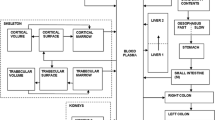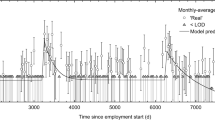Abstract
Uranium is a naturally occurring primordial radioactive element. Small amounts found in air, water, and food are regularly consumed and inhaled by humans. Even the military, medical, and industrial use of depleted uranium can affect humans. There is an appreciable retention of incorporated uranium in skeleton, kidneys, and liver, and a review of respective effective dose coefficients has been given by the International Commission on Radiological Protection (ICRP) in its “Publication 69”; however, data regarding retention in organs or tissues and rates of urinary and fecal excretion for different age groups are incomplete. Therefore, the present study provides retention data that have been calculated for uranium in all compartments and for urinary and fecal excretion, following acute and chronic injection and ingestion for six age groups. The calculations are based on the current ICRP biokinetic model for uranium, and the data can be plotted by using any mathematical software to obtain the retention data at any time after incorporation or to calculate the internal average organ dose induced by uranium provided that specific absorbed fractions are available. The dynamic relationship of the retention in plasma and blood after intravenously and orally administered uranium can easily be derived from the database for injection and ingestion. The calculated contents of uranium in organs or tissues (using the uranium concentration in foodstuffs published by UNSCEAR for Europeans) are compared with autopsy data available in the literature. According to this model, the whole body of a 75-year-old man contains 7 μg uranium, of which 76% is in the skeleton, 1% in the kidneys, and 2.1% in the liver.







Similar content being viewed by others
Notes
This file is available on request from wli@gsf.de
References
Firestone RB (1996) Table of isotopes, 8th CD-ROM edn. Wiley, New York
ICRP (1995) Age-dependent doses to members of the public from intake of radionuclides, Part 3: ingestion dose coefficients. Publication 69. Annals of the ICRP 25(1). Pergamon, Oxford
ICRP (1996) Age-dependent doses to members of the public from intake of radionuclides, Part 5: compilation of ingestion and inhalation dose coefficients. Publication 72. Annals of the ICRP 26(1). Pergamon, Oxford
Polig E (2001) Modeling the distribution and dosimetry of internal emitters: a review of mathematical procedures using matrix methods. Health Phys 81:492–501
United Nations (2000) Sources and effects of ionizing radiation: 2000 report to the General Assembly, with scientific annexes, Vol 1, Annex B. United Nations Scientific Committee on the Effects of Atomic Radiation, United Nations, New York
ICRP (1994) Human respiratory tract model for radiological protection. Publication 66. Annals of the ICRP 24(1–3). Pergamon, Oxford
ICRP (1979) Limits for intakes of radionuclides by workers, Part 1. Publication 30. Annals of the ICRP 2(3–4). Pergamon, Oxford
ICRP (1989) Age-dependent doses to members of the public from intake of radionuclides, Part 1: ingestion dose coefficients. Publication 56. Annals of the ICRP 20(2). Pergamon, Oxford
ICRP (1997) Individual monitoring for internal exposure of workers. Publication 78. Annals of the ICRP 27(3–4). Pergamon, Oxford
ICRP (1993) Age-dependent doses to members of the public from intake of radionuclides, Part 2: ingestion dose coefficients. Publication 67. Annals of the ICRP 23(3–4). Pergamon, Oxford
Skrable K, French C, Chabot G, Major A (1974) A general equation for the kinetics of linear first order phenomena and suggested applications. Health Phys 27:155–157
Birchall A, James AC (1989) A microcomputer algorithm for solving first-order compartmental models involving recycling. Health Phys 56:857–868
Jacquez JA (1985) Compartmental analysis in biology and medicine, 2nd edn. University of Michigan Press, Ann Arbor
Finkelstein L, Carson ER (1986) Mathematical modelling of dynamic biological systems. Research Studies Press, Letchworth, Hertfordshire
Anderson DH (1983) Compartmental modeling and tracer kinetics. Springer, Berlin Heidelberg New York
Godfrey K (1983) Compartmental models and their application. Academic Press, London
Clifford AJ, Müller HG (1998) Mathematical modeling in experimental nutrition. Plenum, New York
Barrett PHR, Bell BM, Cobelli C, Golde H, Schumitzky A, Vicini P, Foster DM (1998) SAAM II: simulation, analysis, and modeling software for tracer and pharmacokinetic studies. Metabolism 47:484–492
ARC (1999) Advanced continuous simulation language (ACSL) reference manual. AEgis Research Corporation, Huntsville, AL
Stefanovski D, Moate PJ, Boston RC (2003) WinSAAM: a windows-based compartmental modeling system. Metabolism 52:1153–1166
Chen J, Meyerhof DP, Tracy BL (2004) Model results of kidney burdens from uranium intakes. Health Phys 86:3–11
SAAM Institute (1997) SAAM II user guide. SAAM Institute, Seattle, WA
Birchall A, Puncher M, James AC, Marsh JW, Jarvis NS, Peace MS, Davies K, King DJ (2003) IMBAEXPERTTM: internal dosimetry made simple. Radiat Prot Dosim 105:421–425
Bundesministerium der Justiz (2001) Bundesgesetzblatt Teil I: Verordnung für die Umsetzung von EURATOM-Richtlinien zum Strahlenschutz, G 5702, Nr. 38, Bundesanzeiger, Bonn
Press WH, Teukolsky SA, Vetterling WT, Flannery BP (2003) Numerical recipes in C++: the art of scientific computing, 2nd edn (reprinted with correction). Cambridge University Press, Cambridge, pp 742–746
Taylor DM, Taylor SK (1997) Environmental uranium and human health. Rev Environ Health 12:147–157
Wrenn ME, Durbin PW, Howard B, Lipsztein J, Rundo J, Still ET, Willis D (1985) Metabolism of ingested U and Ra. Health Phys 48:601–633
Harley NH, Foulkes EC, Hilborne LH, Hudson A, Anthony CR (1999) Depleted uranium, a review of the scientific literature as it pertains to Gulf War illness. RAND Publ. MR-1018/7-OSD. RAND, Santa Monica, CA
Harley NH (2000) The 1999 Lauriston S. Taylor Lecture—back to background: natural radiation and radioactivity exposed. Health Phys 79:121–128
Fisenne IM, Welford GA (1986) Natural U concentrations in soft tissues and bone of New York City residents. Health Phys 50:739–746
Fisenne IM, Perry PM, Welford GA (1980) Determination of uranium isotopes in human bone ash. Anal Chem 52:777–779
Harley NH, Fisenne IM (1990) Distribution and α radiation dose from naturally occurring U, Th and Ra in the human skeleton. Health Phys 58:515–518
Fisenne IM, Perry PM, Harley NH (1988) Uranium in humans. Radiat Prot Dosim 24:127–131
Iyengar GV, Kawamura H, Dang HS, Parr RM, Wang JW, Cho SY, Natera ES (2004) Contents of cesium, iodine, strontium, thorium, and uranium in selected human organs of adult Asian population. Health Phys 87:151–159
Iyengar GV, Kawamura H, Dang HS, Parr RM, Wang J, Akhter P, Cho SY, Natera E, Miah FK, Dojosubroto J, Nguyen MS (2004) Dietary intakes of seven elements of importance in radiological protection by Asian population: comparison with ICRP data. Health Phys 86:557–564
ICRP (2002) Basic anatomical and physiological data for use in radiological protection: reference values. Publication 89. Annals of the ICRP 32(3–4). Pergamon, Oxford
Wrenn ME, Ruth H, Burleigh D, Singh NP (1992) Background levels of uranium in human urine. J Radioanal Nucl Chem 156:407–412
Werner E, Oeh U, Höllriegl V, Roth P, Regulla D (2003) Monitoring of workers and members of the general public for the incorporation of thorium and uranium in the EU and selected countries outside the EU. GSF-Report 09/03. GSF-National Research Center for Environment and Health, Neuherberg
Singh NP, Burleigh DP, Ruth HM, Wrenn ME (1990) Daily U intake in Utah residents from food and drinking water. Health Phys 59:333–337
Fisenne, IM, Perry PM, Decker KM, Keller HW (1987) The daily intake of 234,235,238U, 228,230,232Th and 226,228Ra by New York City residents. Health Phys 53:357–363
Leggett RW (1994) Basis for the ICRP’s age-specific biokinetic model for uranium. Health Phys 67:589–610
Karpas Z (2001) Uranium bioassay-beyond urinalysis. Health Phys 81:460–463
Rodushkin I, Axelsson MD (2000) Application of double focusing sector field ICP-MS for multielemental characterization of human hair and nails, Part I: analytical methodology. Sci Total Environ 250:83–100
Rodushkin I, Axelsson MD (2000) Application of double focusing sector field ICP-MS for multielemental characterization of human hair and nails, Part II: a study of the inhabitants of northern Sweden. Sci Total Environ 262:21–36
Rodushkin I, Axelsson MD (2003) Application of double focusing sector field ICP-MS for multielemental characterization of human hair and nails, Part III: direct analysis by laser ablation. Sci Total Environ 305:23–39
Gonnen R, Kol R, Laichter Y, Marcus P, Halicz L, Lorber A, Karpas Z (2000) Determination of uranium in human hair by acid digestion and FIAS-ICPMS. J Radioanal Nucl Chem 243:559–562
Byrne AR, Benedik L (1991) Uranium content of blood, urine and hair of exposed and non-exposed persons determined by radiochemical neutron activation analysis, with emphasis on quality control. Sci Total Environ 107:143–157
ATSDR (2001) Hair analysis panel discussion: exploring the state of the science. Agency for Toxic Substances and Disease Registry, Atlanta, GA
Karpas Z, Paz-Tal O, Lorber A, Salonen L, Komulainen H, Auvinen A, Saha H, Kurttio P (2005) Urine, hair and nails as indicators for ingestion of uranium in drinking water. Health Phys 88:229–242
Acknowledgements
This work was partly supported by EU Contract FIKR-CT2001-00164. Special thanks are due to Ms Roedler-Vogelsang for linguistic revision and for valuable comments on the manuscript.
Author information
Authors and Affiliations
Corresponding author
Appendix
Appendix
Let k3mo, k1y, k5y, k10y, k15y, and kadult be the transfer rates for different ages of an infant, 1-year-old, 5-year-old, 10-year-old, 15-year-old, and adult (≥25 years old), respectively. The transfer rates, kfrom age, change over time, t, after intake at different ages as follows:
Rights and permissions
About this article
Cite this article
Li, W.B., Roth, P., Wahl, W. et al. Biokinetic modeling of uranium in man after injection and ingestion. Radiat Environ Biophys 44, 29–40 (2005). https://doi.org/10.1007/s00411-005-0272-0
Received:
Accepted:
Published:
Issue Date:
DOI: https://doi.org/10.1007/s00411-005-0272-0




